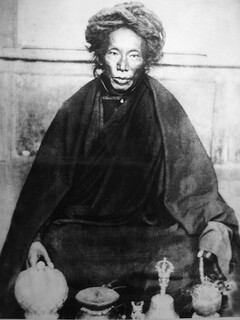Yamāntaka to Pacify Epidemics
English | Deutsch | Español | Français | Italiano | 中文 | བོད་ཡིག
༁ྃ༔ གཤིན་རྗེ་དཔའ་གཅིག་དྲུག་ཅུ་ལས༔ ང་བཞི་པ་ནད་རིམས་ཞི་མཛད་ཀྱི་སྒྲུབ་ཐབས་བཞུགས་སོ༔
54. The Method to Pacify All Epidemics, Illnesses and Pandemics
From the Sixty Solitary Forms of Yamāntaka
revealed by Tertön Sogyal Lerab Lingpa
༁ྃ༔ རྡོ་རྗེ་ནད་རིམས་ཞི་མཛད་ལྗང་༔
dorjé né rim zhidzé jang
I appear as Yamāntaka, the Vajra Pacifier of All Illness,
ཞལ་གཅིག་ཁྲོ་འཛུམ་སྤྱན་གསུམ་པ༔
zhal chik tro dzum chen sumpa
Green in colour, with three eyes, and smiling with a hint of wrath.
མཆེ་གཙིགས་ཤངས་ནས་ཡེ་ཤེས་རླུང་༔
chetsik shang né yeshe lung
As I bear my fangs, a five-coloured wisdom wind emerges from my nose
འོད་ལྔའི་ཚུལ་འཕྲོས་སྡུག་བསྔལ་སེལ༔
ö ngé tsul trö dukngal sel
And eradicates all forms of suffering.
སྐུ་སྟོད་གཅེར་བ་རུས་པས་བརྒྱན༔
kutö cherwa rüpé gyen
My upper body is naked but for ornaments of bone,
སྐུ་སྨད་དར་དམར་ཤམ་ཐབས་མཛེས༔
kumé dar mar shamtab dzé
My lower body wreathed in a garment of red silk.
ཕྱག་གཉིས་མཉམ་བཞག་མཛད་པའི་སྟེང་༔
chak nyi nyamzhak dzepé teng
My two hands rest in a gesture of meditation
བདུད་རྩི་སྨན་གྱི་བུམ་བཟུང་ཐོགས༔
dütsi men gyi bum zung tok
And cradle a delicate vase filled with medicinal nectar.
ཞབས་གཉིས་མཉམ་པའི་སྟབས་ཀྱིས་བཞེངས༔
zhab nyi nyampé tab kyi zheng
With my two legs standing in a posture of evenness,
ཡེ་ཤེས་མེ་འོད་ཀློང་ན་གསལ༔
yeshe mé ö long na sal
I appear vividly clear amidst the brilliance of wisdom fire.
དེ་ནས་བཟླས་པའི་རིམ་པ་ནི༔
For the stages of mantra repetition:
ཐུགས་ཀར་པད་ཟླའི་སྟེང་དུ་འཇམ་དབྱངས་དཀར་པོ་ལོངས་སྐུའི་རྒྱན་ཅན་ཕྱག་གཉིས་བུམ་པ་བདུད་རྩིས་གང་བ་བསྣམས་པའི་ཐུགས་ཙིཏྟ་རིན་པོ་ཆེའི་ནང་དུ༔
tukkar pé dé tengdu jamyang karpo longkü gyenchen chak nyi bumpa dütsi gangwa nampé tuk tsitta rinpoche nang du
White Mañjuśrī sits at my heart wearing the ornaments of the saṃbhogakāya and holding a vase filled with nectar. Within the precious enclosure of his heart
ཟླ་སྟེང་ཧཱུྃ་ཡིག་དཀར་པོའི་མཐར༔
da teng hung yik karpö tar
Is a white syllable Hūṃ standing on a moon disk.
སྔགས་ཕྲེང་སྐར་མའི་ཕྲེང་བ་ལྟར༔
ngak treng karmé trengwa tar
It is encircled by a mantra arranged like a constellation of stars.
འཁོར་བའི་འོད་ཀྱིས་དོན་གཉིས་བྱས༔
khorwé ö kyi dön nyi jé
The light of the garland performs the twofold purpose;
ཁྱད་པར་ཟླ་ཞུན་ལྟ་བུའི་འོད༔
khyepar da zhün tabü ö
Its moonlight radiance in particular,
དྭངས་བསིལ་བདུད་རྩི་དང་བཅས་འཕྲོས༔
dang sil dütsi dangché trö
Filled with a pure, cooling nectar,
རང་གཞན་ནད་རིམས་རྒྱུ་རྐྱེན་བཅས༔
rangzhen né rim gyukyen ché
Heals and purifies all epidemics, illnesses and pandemics,
ཞི་ཞིང་དག་ནས་བདེ་སྟོང་གི༔
zhi zhing dak né detong gi
Along with their respective causes and conditions for myself and others.
ཡེ་ཤེས་རྒྱུད་ལ་སྐྱེས་ནས་ཀྱང་༔
yeshe gyü la kyé né kyang
It induces the wisdom of bliss and emptiness
ཟག་མེད་རྡོ་རྗེ་ལྟ་བུའི་སྐུ༔
zakmé dorjé tabü ku
And renders evident the uncontaminated vajra-kāya
བསྒྲེས་རྒུད་མེད་པའི་རང་བཞིན་བསམ༔
dré gü mepé rangzhin sam
That is naturally free of ageing and decay.
ཨོཾ་མཉྫུ་ཤྲཱི་ཀྲོ་དྷ་ར་དྷི་པ་ན་ཨ་ཙ་ཡེ་ཧཱུྃ་ཕཊ༔
om manjushri krodha radhi pana atsaye hung pé
oṃ mañjuśrī krodha ra dhi pa na a tsa ye hūṃ phaṭ
འབུམ་ཕྲག་དྲུག་གིས་ནད་རིམས་ཞི༔ ཚེ་རབས་ཀུན་ཏུ་ནད་མེད་པའི༔ བདེ་བ་ཕུན་སུམ་ཚོགས་ཐོབ་འགྱུར༔ ས་མ་ཡ༔
Repeating the mantra 600,000 times will heal all illness and pandemics, and ensure that you are forever without illness and acquire bountiful bliss and comfort. Samaya.
ལས་རབ་གླིང་པས་ཀ་རོན་བྲག་དཀར་རྫ་མདུན་དུ་བྲིས་པ་དགེ། མངྒ་ལཾ།།
Lerab Lingpa set this down in front of the white rocks of Karon. Maṅgalaṃ.
| Translated by Sean Price 2020, at the command of the sublime Lama Yönten of Nyakrong (and Lerab Ling).
Source:
Las rab gling pa. "gshin rje dpa' gcig drug cu las:_nad rims zhi mdzad kyi sgrub thabs:" In las rab gling pa'i gter chos/. BDRC W21810. Bylakuppe: Pema Norbu Rinpoche, 1985-. Vol. 7: 341–342.
Version: 1.1-20210709
